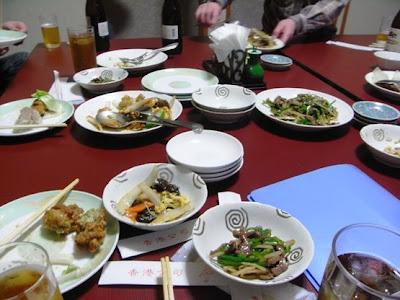As I wrote in the previous post, on 13th and 21st March hubby and I went to see a doll festival known as Yurihonjo hinakaido. The festival is a public annual traditional display of dolls and is held in six public exhibition halls as well as fifty different locations within Yurihonjo city of Akita prefecture. This festival event is held in the month of March. While
hina matsuri is a private display of hina dolls at homes of families with daughters, hinakaido festival is a public display of antique hina dolls some of which date back at least several hundred years. In the
previous post I wrote about the display of
Edo period hina dolls at Yashima kyodo bunka hozon denshu shisetsu in Yashima. Today I will write about our visit to Shushin-kan in Honjo Park where exquisite hina dolls were displayed in an exhibition room.
Shushin-kan in Honjo ParkOn 21st March, hubby and I went to see the display of hina dolls at Shushin-kan in Honjo Park. Honjo Park is located on the site of Honjo Castle which was built in 1613. Shushin-kan and Honmaru-no-yakata are two halls located in the center of the park. We can learn about the history and culture of Honjo at these two halls. Although hina doll display was held in both the halls, we visited only Shushin-kan hall. The park is located about three kilometers away from our home and it took us ten minutes to reach there by our car. Various types of old and exquisite hina doll sets like kokinbina and kyohoubina were exhibited in one of the rooms of Shushin-kan hall. The exhibition room looked so beautiful with several hina doll sets. We moved inside the room in a counterclockwise direction and enjoyed seeing the antique doll sets one at a time.
Kami-ningyo paper dolls of Mishima MichiThe first hina doll set on display was made by Mishima Michi. She was an elementary school teacher. In 1961, after retiring from her job as a teacher, she started making kami-ningyo paper dolls using
washi Japanese paper. These kami-ningyo dolls are made of Tosa washi paper of Kochi prefecture. Three-dimensional dolls are one of the salient features of Mishima Michi’s paper dolls. The dolls on display have two dimensional traditional collars that express the beauty of shoulder line, and the entire shape of dolls have a three-dimensional feeling. These dolls were donated by Mishima Eiji to the local historical artifacts museum named Honjo kyodo shiryokan in 1998.

Kami-ningyo paper dolls of Mishima Michi
Emperor and empress (dairibina) paper dolls made by Mishima Michi
Hina dolls of Watanabe-keThe second set of hina dolls on display belongs to the family (ke in Japanese) of Watanabe Yoshio of Mikura town. On the back of the case where this doll set is kept, the year 1838 is written which is probably the year the dolls were bought. It is also written on the case that the doll set belongs to Jou-un-in. Jou-un-in was the wife of the ninth feudal lord Rokugo Masatsune of Honjo-
han of
Dewa province. The wife was originally from
Ise province and moved to Honjo after marriage to the feudal lord. These hina dolls do not have pedestal. The height of emperor and empress dolls (dairibina) is 45 cm, which is very large. These dairibina dolls are of the type kyohoubina. The dolls have gorgeous clothes and kazari (accessory) decorations, which is one of the salient features of kyohoubina dolls. The gorgeous clothes and the hugeness of these dolls represent the peak of hina matsuri festival during Edo period.

Hina dolls of Watanabe-ke
Dairibina dolls of Watanabe-ke
Empress (ohinasama) doll of Watanabe-ke
Emperor (odairisama) doll of Watanabe-ke
Five male dolls representing musicians (gonin bayashi) kept on the right side of dairibina dolls of Watanabe-ke
Five male dolls representing samurai attendants and ministers kept on the left side of dairibina dolls of Watanabe-ke
Hubby appreciating the hina dolls of Watanabe-ke
Me standing in front of hina dolls of Watanabe-ke
Hina dolls donated by Sudo-keThe third set of hina dolls on display was donated by Sudo family. This doll set is of the type Kyohoubina and was made in 1853. Odairisama (emperor) and ohinasama (empress) dolls look very elegant and the clothes of the dolls look gorgeous and well maintained.

Hina dolls donated by Sudo-ke
Dairibina dolls of Sudo-ke
Ohinasama doll of Sudo-ke
Hina dolls donated by Miura-keThe fourth doll set on display was donated by Miura family. This doll set is of the type kokinbina and was made in the beginning of
Showa period. The dolls are well maintained and look almost practically new.

Hina dolls donated by Miura-ke
Dairibina dolls and three court ladies (san-nin kanjo) of Miura-ke
Ohinasama doll of Miura-ke
Hina dolls donated by Miura family were the last ones on display in the exhibition room. Shushin-kan hall is basically a facility to learn about the history and culture of Honjo. So we moved around inside the hall and saw various exhibits related to the history of Honjo. There was an armor set on display which belonged to Kusunoki family of Yurihonjo, who later donated it to Honjo kyodo shiryokan museum. Family crest of a famous samurai
Kusunoki Masashige is put on the armor. He is remembered as an ideal of samurai loyalty and belonged the transition era from
Kamakura period to
Nanbokucho period. Although the family crest of the famous samurai is there on the armor but little is known about its origin and it is unclear as to how the armor reached Kusunoki family of Yurihonjo.

Hubby standing next to a samurai armor that has family crest of Kusunoki Masashige
Top portion of the samurai armor
We enjoyed seeing the antique hina doll display at Shushin-kan hall in Honjo Park.




































































